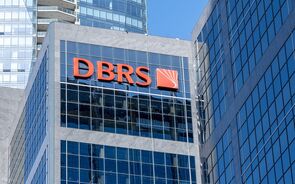13:30 - Dados States
1 Mensagem
|Página 1 de 1
13:30 - Dados States
8:29am 07/29/04 U.S. WEEKLY INITIAL JOBLESS CLAIMS UP 4,000 TO 345,000
8:29am 07/29/04 U.S. 4-WK AVG. JOBLESS CLAIMS OFF 1,000 TO 336,250
8:30am 07/29/04 U.S. WEEKLY CONTINUOUS JOBLESS CLAIMS UP 174K TO 2.96M
8:30am 07/29/04 U.S. Q2 EMPLOYMENT COST INDEX UP 0.9% AS EXPECTED
8:30am 07/29/04 U.S. Q2 WAGES AND SALARIES UP 0.6%, SAME AS Q1
8:30am 07/29/04 U.S. Q2 BENEFIT COSTS UP 1.8% VS. 2.4% Q2
8:30am 07/29/04 U.S. ECI YEAR-OVER-YEAR UP 4 PERCENT
8:30am 07/29/04 U.S. BENEFIT COSTS UP 7.2% YEAR-OVER-YEAR, 14-YEAR HIGH
8:30am 07/29/04 U.S. PVT-SECTOR BENEFIT COSTS UP 7.3% Y-O-Y, 20-YR HIGH
ECONOMIC REPORT: U.S. jobless claims stabilize; 4-week average falls 1,000 to 336,250
By Rex Nutting, CBS.MarketWatch.com
Last Update: 8:33 AM ET July 29, 2004
WASHINGTON (CBS.MW) - U.S. initial jobless claims rose by 4,000 to 345,000 in the week ending July 24, the Labor Department said Thursday.
The four-week average of new claims - which smoothes out distortions in the weekly figures caused by weather and other one-time factors -- fell by 1,000 to 336,250. It's the lowest in three weeks.
The increase in weekly claims was in line with expectations on Wall Street, where economists were looking for about 344,000 new filings.
Meanwhile, the number of Americans continuing to receive state unemployment benefits rose by 174,000 to 2.96 million in the week ending July 17, the highest in eight weeks.
The insured unemployment rate - the percentage of claims among those eligible for benefits - rose to 2.3 percent from a cycle low of 2.2 percent a week earlier.
The data on layoffs come a week and a day before the Labor Department issues its monthly employment report covering July. Economists are currently expecting nonfarm payrolls to rise about 225,000 in July after 112,000 new jobs were created in June.
During the July survey week (the week containing the 12th of the month), initial claims were up by 5,000 compared with the June survey week to 341,000. Continuing claims were up by 8,000 compared with June at 2.96 million.
After plunging by about 60,000 in the last six months of 2003, the level of initial claims is largely unchanged over the past three months
Initial and continuing claims are now at levels consistent with job growth of about 150,000 to 250,000 a month, economists say.
Continuing claims have fallen by about 400,000 since the beginning of the year.
The steady decline in the continuing claims figures could be a sign of increased hiring. Or it could also indicate that some workers are exhausting their benefits before finding work. It's likely a combination of the two factors.
Long-term unemployment has been particularly insidious during this business cycle. In June, 1.8 million, or 21.6 percent, of the 8.2 million workers classified as unemployed had been out of work longer than six months. The average duration of unemployment remained high at 19.9 weeks.
ECONOMIC REPORT: U.S. employment costs up 0.9%; Benefit costs up 7.2% in past year, most in 14 years
By Rex Nutting, CBS.MarketWatch.com
Last Update: 8:32 AM ET July 29, 2004
WASHINGTON (CBS.MW) - U.S. compensation costs increased 0.9 percent in the second quarter after a 1.1 percent gain in the first, the Labor Department reported Thursday.
The increase in the employment cost index matched Wall Street expectations.
Benefit costs continued to outpace wage gains.
Benefit costs increased 1.8 percent in the quarter, down from 2.4 percent in the first quarter. Wages and salaries increased 0.6 percent, matching the first quarter's gain.
Over the past year, employment costs have increased 3.9 percent, up from 3.8 percent in the first quarter. Wages and salary costs have increased 2.5 percent in the past year, while benefit costs increased 7.2 percent since the second quarter of 2003.
It's the largest year-over-year gain in benefit costs since 1990.
Benefit costs have soared because health-care costs continue to mount. In addition, many employers are contributing more to defined-benefit pension plans that are severely underfunded.
For private-sector workers, the ECI increased 1 percent in the second quarter as wage costs increased 0.6 percent and benefit costs increased 1.7 percent.
In the past year, the ECI for private-sector workers is up 4 percent, with wage costs up 2.6 percent and benefit costs rising 7.3 percent, the most in 20 years.
The ECI is considered one of the best gauges of cost pressures that could fuel inflation.
So far, the Federal Reserve has remained sanguine about the impact of employment costs on inflation, arguing that productivity gains have allowed employers to meet higher employment costs without raising prices or cutting into profits.
Looking ahead, the Fed has said it expects productivity increases to moderate somewhat. Profits, which have been at record levels, are likely to be squeezed by slower productivity growth, because intense competition and still-slack labor markets will work to keep price pressures contained, Fed officials say.
Economists were expecting a 0.9 percent gain in the ECI after rising 1.1 percent in the first quarter.
8:29am 07/29/04 U.S. 4-WK AVG. JOBLESS CLAIMS OFF 1,000 TO 336,250
8:30am 07/29/04 U.S. WEEKLY CONTINUOUS JOBLESS CLAIMS UP 174K TO 2.96M
8:30am 07/29/04 U.S. Q2 EMPLOYMENT COST INDEX UP 0.9% AS EXPECTED
8:30am 07/29/04 U.S. Q2 WAGES AND SALARIES UP 0.6%, SAME AS Q1
8:30am 07/29/04 U.S. Q2 BENEFIT COSTS UP 1.8% VS. 2.4% Q2
8:30am 07/29/04 U.S. ECI YEAR-OVER-YEAR UP 4 PERCENT
8:30am 07/29/04 U.S. BENEFIT COSTS UP 7.2% YEAR-OVER-YEAR, 14-YEAR HIGH
8:30am 07/29/04 U.S. PVT-SECTOR BENEFIT COSTS UP 7.3% Y-O-Y, 20-YR HIGH
ECONOMIC REPORT: U.S. jobless claims stabilize; 4-week average falls 1,000 to 336,250
By Rex Nutting, CBS.MarketWatch.com
Last Update: 8:33 AM ET July 29, 2004
WASHINGTON (CBS.MW) - U.S. initial jobless claims rose by 4,000 to 345,000 in the week ending July 24, the Labor Department said Thursday.
The four-week average of new claims - which smoothes out distortions in the weekly figures caused by weather and other one-time factors -- fell by 1,000 to 336,250. It's the lowest in three weeks.
The increase in weekly claims was in line with expectations on Wall Street, where economists were looking for about 344,000 new filings.
Meanwhile, the number of Americans continuing to receive state unemployment benefits rose by 174,000 to 2.96 million in the week ending July 17, the highest in eight weeks.
The insured unemployment rate - the percentage of claims among those eligible for benefits - rose to 2.3 percent from a cycle low of 2.2 percent a week earlier.
The data on layoffs come a week and a day before the Labor Department issues its monthly employment report covering July. Economists are currently expecting nonfarm payrolls to rise about 225,000 in July after 112,000 new jobs were created in June.
During the July survey week (the week containing the 12th of the month), initial claims were up by 5,000 compared with the June survey week to 341,000. Continuing claims were up by 8,000 compared with June at 2.96 million.
After plunging by about 60,000 in the last six months of 2003, the level of initial claims is largely unchanged over the past three months
Initial and continuing claims are now at levels consistent with job growth of about 150,000 to 250,000 a month, economists say.
Continuing claims have fallen by about 400,000 since the beginning of the year.
The steady decline in the continuing claims figures could be a sign of increased hiring. Or it could also indicate that some workers are exhausting their benefits before finding work. It's likely a combination of the two factors.
Long-term unemployment has been particularly insidious during this business cycle. In June, 1.8 million, or 21.6 percent, of the 8.2 million workers classified as unemployed had been out of work longer than six months. The average duration of unemployment remained high at 19.9 weeks.
ECONOMIC REPORT: U.S. employment costs up 0.9%; Benefit costs up 7.2% in past year, most in 14 years
By Rex Nutting, CBS.MarketWatch.com
Last Update: 8:32 AM ET July 29, 2004
WASHINGTON (CBS.MW) - U.S. compensation costs increased 0.9 percent in the second quarter after a 1.1 percent gain in the first, the Labor Department reported Thursday.
The increase in the employment cost index matched Wall Street expectations.
Benefit costs continued to outpace wage gains.
Benefit costs increased 1.8 percent in the quarter, down from 2.4 percent in the first quarter. Wages and salaries increased 0.6 percent, matching the first quarter's gain.
Over the past year, employment costs have increased 3.9 percent, up from 3.8 percent in the first quarter. Wages and salary costs have increased 2.5 percent in the past year, while benefit costs increased 7.2 percent since the second quarter of 2003.
It's the largest year-over-year gain in benefit costs since 1990.
Benefit costs have soared because health-care costs continue to mount. In addition, many employers are contributing more to defined-benefit pension plans that are severely underfunded.
For private-sector workers, the ECI increased 1 percent in the second quarter as wage costs increased 0.6 percent and benefit costs increased 1.7 percent.
In the past year, the ECI for private-sector workers is up 4 percent, with wage costs up 2.6 percent and benefit costs rising 7.3 percent, the most in 20 years.
The ECI is considered one of the best gauges of cost pressures that could fuel inflation.
So far, the Federal Reserve has remained sanguine about the impact of employment costs on inflation, arguing that productivity gains have allowed employers to meet higher employment costs without raising prices or cutting into profits.
Looking ahead, the Fed has said it expects productivity increases to moderate somewhat. Profits, which have been at record levels, are likely to be squeezed by slower productivity growth, because intense competition and still-slack labor markets will work to keep price pressures contained, Fed officials say.
Economists were expecting a 0.9 percent gain in the ECI after rising 1.1 percent in the first quarter.
-
Info.
1 Mensagem
|Página 1 de 1
Quem está ligado:
Utilizadores a ver este Fórum: Google [Bot], Shimazaki_2 e 41 visitantes


